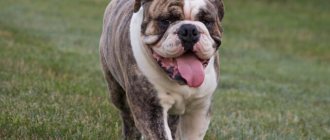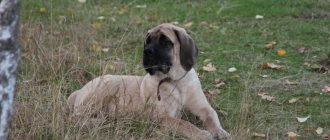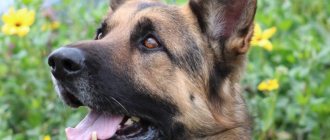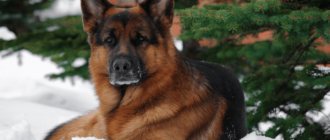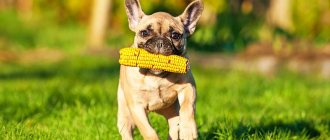The character of a dog depends on heredity and breed characteristics, but proper upbringing and training is also of no small importance. In this article we will tell you about the natural characteristics of the breed and how to properly start raising and training your pet.
The Sheltie (Shetland Sheepdog) was found in the Shetland Islands off the coast of Scotland, keeping hungry birds and sheep away from farmer's gardens and also serving as herding dogs. Today they are excellent family companions and superstars in dog sports.
- Country of origin : UK
- Height at withers : male 34-40 cm, female 32-37 cm
- Weight : male: 6.4–12 kg, female: 6.4–12 kg
- Lifespan : 12-13 years
- Use : companion dog, shepherd
- Other names : Shetland Sheepdog
Features and description
These are very brave and strong shepherd dogs that get along well not only with livestock, but also with people. The second name of the breed is Shetland Sheepdog, with an “e”, since the breed appeared on the Shetland Islands. She is the smallest among the four-legged shepherds and, perhaps, the most charming.
Sheltie, one of the smallest herding dogs
In Scotland, this animal was used to look after a small herd of cows or sheep. Also, the dog often had to protect chickens and ducks. The development of the agricultural sector in the world led to the almost complete disappearance of the breed. Shelties were replaced by larger and braver shepherd dogs. But, fortunately, these charming dogs have fans who did not let them disappear.
People who liked the cute and efficient Shetland Sheepdogs began to actively select them. As a result, representatives of the breed quickly spread throughout the world. No one can say which dogs' genes were most likely used to breed these dogs. But even an inexperienced breeder will say that to breed modern Shelties, professionals probably used collie and Spitz genes.
Today, these wonderful dogs are rarely used for farm work. They are more valued as comrades and companions. The Sheltie is an ideal family pet. She is kind, affectionate, and good at communicating.
Breeders of this breed advise starting it with a pensioner who has been deprived of attention. Practice proves that interaction with a dog improves mood and well-being. This pet is also suitable for large families. He gets along with children of different ages and genders.
Sheltie finds a common language with all pets living in the house and children
You shouldn’t count on a Shetland Sheepdog to guard your apartment. Yes, it can be trained so that it begins to react to the arrival of strangers. But this cute beast will not harm anyone.
Basic commands
You will use some commands more often, others less often. But they will still come in handy to easily interact with the Sheltie and even keep him safe in various situations.
- Aport. One of the most difficult teams. Many people perceive it as very easy and simple, but with many dogs you will have to work hard. This skill is used for other exercises: searching, searching, selecting an item and many others. Usually they are all used in service. When working out a command, “Aport” and “Give” are used, and a gesture is also used.
- Give. On the command “Give” the dog must give up the object.
- Lie. A connecting command that needs to be learned for other commands. In addition, it will not interfere at home or on the street.
- To me. You will need to use this command quite often. So start with it immediately after your Sheltie puppy has learned his name. Never call the dog to punish, and do not scold if it comes on its own, even after mischievousness before it. This behavior on your part may alienate the animal.
- Place. A puppy or an adult dog must clearly know where his place is located. He can sleep anywhere, if you allow it, of course, but he must know this command. You can use it outside the home, marking the place with a leash or your favorite toy.
- Near. It is possible to teach your pet the “Near” command at any age, be it an adult dog or a small puppy. When you move to a new home, you should immediately think about training your puppy.
- Sit. One of the very first commands that a Sheltie puppy should learn.
- Stand. The command is useful in everyday life, for example, for combing a dog.
- . The prohibiting command is one of the most mandatory and taming it begins from the first day the puppy appears in the house. Requiring the command “Fu!”, “No!”, “No!” - immediately stop the unwanted action.
Breed standard
The Sheltie dog is small and agile. She is completely uncharacteristic of clumsiness. The height of an adult at the withers is from 34 to 38 cm. Males are several centimeters taller than females. If a dog's height is higher than this mark, it cannot be considered a purebred.
A shepherd dog weighs from 5 to 8 kg. It is folded harmoniously. Every part of her body looks great when combined with the rest. The dog has an elongated rectangular body, a fairly wide back, and a strong, neat neck.
The animal's legs are set parallel and have lean muscles. Very strong, short. The joints on the paws are strong. The dog's sternum deepens to the elbow joints. The bulge is clearly visible on the lower back. There is an excellent arch in the rib area. The shepherd's tail is set low. It bends slightly upward, but is almost invisible due to the lush fur. According to the standard, it cannot be broken.
From shepherds, Shelties have become loyal friends and companions.
These wonderful animals have a graceful gait. They move smoothly and slowly, preferring to remain calm in any situation. The dog's head is small and its muzzle is elongated. Her ears are located close to each other. Medium in thickness and pointed at the tips.
The occipital protuberance is practically invisible on the head. The cheeks are slightly sunken and flat. There is pigmentation in the area of the nose and lips. The dog's slanting tiny eyes are almond-shaped in shape. The color of the iris is brown or black.
Interesting! Some representatives of the breed are born with heterochromia. This is a specific phenomenon consisting of the presence of different colored eyes. For example, an individual may be born with a blue and a black eye.
The Sheltie in the photo is depicted as interested, attentive and observant. Perhaps this is due to the small and slightly sunken eye sockets, but, rather, this image is an indicator of the dog’s character. According to the standard, her jaw should be symmetrical. Well defined chin. The bite is scissor-shaped. The teeth are sharp and white. There should be 42 of them.
The fur of such dogs is luxurious. It should be shiny, a little stiff and long. High-breed Scottish Sheepdogs have the longest fur on their necks. This makes the dog seem like a lion, as it has a “mane.” But on the muzzle it is short.
Origin story
The ancestors of the modern Sheltie originate from the Shetland Islands, the northernmost territory of the United Kingdom. They are believed to have originated from crossing local Spitz dogs, Border Collies and other Scottish herding dogs. In their homeland, the dogs were originally called “tuni dog” (from the Gaelic tuathanas - “farm”). The modern type was formed by the end of the 19th century.
The resemblance to a collie is worth mentioning separately. Seeing that the dogs were similar, English breeders began to purposefully create a miniature copy of their favorite breed, rather than focusing on the original qualities. At the turn of the 19th and 20th centuries, as well as after World War II, Shelties were even infused with the blood of Scottish Sheepdogs.
Collie, Sheltie and Border Collie dogs
In the 20th century, Shelties as shepherds were no longer needed, but the breed was preserved through the efforts of enthusiasts who saw them as companions. In 1908, a breed club was created in Lerwick, the capital of the Shetland Islands, and breeders attempted to unify the breed: they called it the Shetland Sheepdog, created stud books and developed a standard. In 1909, a breed club was founded in Scotland, and in 1914 in England. In 1917, the first dog named Woodwold received the championship title. In the subsequent war and post-war years, there were practically no breeding dogs left in Europe. It was not until 1948 that the various English Kennel Clubs worked together to restore the population and agree on and adopt a standard.
Sheltie lines in the USA deserve special attention. The first Shetland Sheepdogs were imported to the States from England at the beginning of the twentieth century. Purposeful work on breeding and improvement began in the 20s. Breeders led by Frederick Fry founded the American Sheltie Association and already in 1929 the AKC registered the first standard.
Video review about the Sheltie dog breed:
Kinds
The Sheltie breed was standardized once, so its varieties are not distinguished. However, these wonderful shepherd dogs can be classified by color. Possible options:
- Black-red-white (more common than others).
- White black.
- Blue-red-white (blue morel).
- Sable.
High-breed representatives are united by the presence of a large white spot on the sternum. There may also be light markings on dogs' paws and faces. Their presence in these areas is preferable. But reddish-brown spots on the Sheltie’s body are extremely undesirable.
Pros and cons of the breed
Before purchasing a Shetland Sheepdog, the future owner must be aware of the responsibility, so it is recommended that you familiarize yourself with the advantages and disadvantages of this breed.
Pros:
- a wonderful family friend;
- knows how to obey and is easy to learn;
- is suitable and needs to live at home or in an apartment;
- gets along with children and other pets;
- fits into the active lifestyle of the owner.
Minuses:
- not suitable as a security guard;
- needs special coat care;
- there is a predisposition to certain diseases;
- not suitable for a passive lifestyle.
The Sheltie becomes very attached to its owner and has a hard time with separation. Having assessed the pros and cons of the future, the owner will be able to understand whether he is ready to have such a pet and provide him with everything necessary.
Character
Experts insist that the Shetland Sheepdog is one of the best companion dogs. She loves the people around her very much, quickly becomes attached to them, and is always nearby. This is an incredibly gentle creature who is always ready to share her love with others. It can gently rub its head against its owner's hand, begging for his attention. In response to affection, he wags his tail cheerfully.
The dog is very friendly. Rancor is not characteristic of her. He always warmly welcomes guests, does not get angry and does not rush at any of them. Even drunk people do not cause negative emotions in Shelties. If the dog understands that a particular person is inadequate, he will not interact with him, but will simply move away.
A shepherd will always find a common language with a child, because she is very sociable. Regardless of age, such a dog will definitely enjoy playing with the baby. All herding dogs are good house sitters, and Shelties are no exception.
Sheltie is often considered a small collie, but they are completely different breeds of dog in their own right.
Strangers may be viewed with distrust, especially if they do not interact with others respectfully. They have an extremely negative attitude towards anger, manifestations of aggression of any kind, screaming, etc. Such a dog is deeply hurt by someone else’s abuse, since by nature it is very vulnerable and sensitive. But she herself is rarely offended.
However, even such a cute dog is capable of vanity. No, his self-esteem is not inflated, it’s just that a beautiful animal knows his worth and will not allow him to be treated without respect. He needs not only care, but also support, adequate assessment and even admiration. Praising your beloved owner will make him very happy.
Interesting! The Shetland Sheepdog can make many interesting sounds. And her “arsenal” includes bird chirping, cat purring and barking typical of dogs. It can be either noisy or quiet, depending on your mood.
Health, illness, life expectancy
Shelties are very hardy and adapt well to different weather conditions. In most cases, Shetland Sheepdogs are distinguished by good health and good immunity, and their average life expectancy is 12-13 years. Meanwhile, the breed has a number of diseases to which it is predisposed:
- Hernias;
- Epilepsy;
- Heart defects;
- Hypothyroidism;
- Lupus;
- Various types of dermatitis and allergies;
- Ear and eye diseases;
- Cryptorchidism;
- Von Willebrand's disease (poor blood clotting).
Shelties have been shown to be hypersensitive to certain medications.
A short list of dangerous drugs and active substances:
- cyclosporine;
- Loperamide;
- vincristine;
- Rifampicin and many others.
Against fleas and ticks, drugs with the following active ingredients should be used with caution or completely avoided:
- Moksidektin;
- ivermectin;
- Berenil;
- veriben;
- Selamectin.
Care and maintenance
A small herding dog needs frequent exposure to nature, preferably near farm animals. But it cannot be said that life in an apartment will seem boring to the Sheltie. If you, living in a small room without access to the yard, want to get such a dog, we also recommend that you “settle” other animals on your territory: cats, birds, lizards, turtles, etc.
The dog will definitely find a common language with any pet. But you need to communicate with him in their presence correctly. It is important that he does not become jealous of his owner towards other living creatures. Therefore, you should not deprive him of attention.
When caring for a shepherd, special attention should be paid to its coat. It is rather harsh and long, so it needs regular cleaning and combing. For silk, you can choose a comb with stiff bristles or a massager with elongated teeth. A representative of this breed sheds in the warm season, mainly in summer.
If such a dog is not combed, long tangles will form all over its body. In this case, his coat will lose its presentable appearance. He doesn't need frequent bathing. We recommend choosing good healthy shampoos.
Also, do not forget to clean your pet:
- The eyes are sour.
- Teeth from plaque.
- Ears from wax.
Health and vaccination
Conjunctivitis is a common disease among Sheltie puppies.
Vaccinations should be carried out according to schedule. Therefore, you need to consult with your veterinarian in advance so that he can tell you when vaccinations should be given. However, vaccination does not help protect your pet from all diseases. There are several diseases that Shelties suffer from most often:
- skin dermatitis;
- endocrine disorders;
- hip dysplasia;
- conjunctivitis;
- dysfunction of the central nervous system.
Important! If symptoms of a particular disease appear, you should immediately contact a veterinarian and do not self-medicate.
Shelties are dogs that are popular among dog breeders from the Russian Federation and Europe. People who want to get such a puppy should understand in advance the features of caring for it at home.
Nutrition
A Sheltie puppy be fed differently than an adult representative of the breed. Until it is fully formed, you need to help its body enrich itself with useful substances: calcium, vitamins A, B and C, zinc, iron, bacteria for digesting food, etc.
A commercial diet is indicated only for adult Shetland Sheepdogs whose bodies are already fully developed. Kids should be given: cottage cheese, boiled eggs, meat products, milk, fresh fruits, boiled potatoes, fresh vegetables and berries. It is worth limiting its consumption: pasta, fatty meat broths, chocolate, smoked meats and baked goods.
Important! Giving such a dog sharp bones, as well as meat that may contain them, is strictly prohibited.
You can also treat your puppy to low-fat boiled fish, beef, broccoli, mushrooms or soups. Among flour products, he is allowed the following semi-finished products: homemade dumplings and dumplings, pancakes, pizza. But don't let your pet eat too much flour products, because they increase gas formation in the stomach.
Choosing a puppy and price of Sheltie
Choosing a puppy is a responsible undertaking, especially when it comes to buying a purebred dog that must meet the standard and have the desired appearance and character.
It is worth considering that in one litter there can be “dwarfs” and “giants”; if a Shetland Sheepdog is needed for a family “on the sofa”, then this drawback is not significant, but if you plan to participate in an exhibition or breeding, such a drawback can put an end to your career. Sheltie wool also does not always correspond to the picture. Therefore, when purchasing, it is important to visually evaluate the baby’s parents. Breeders' excuses that dad is gone and mom is out of shape should be alarming. It is very important to evaluate the living conditions and grooming of all dogs, especially adults. Puppies must be visually healthy and active.
Unfortunately, determining future prospects is very difficult even for experienced breeders.
In some cases, it makes more sense to buy older puppies, especially for families in which everyone works. Even at the age of a teenager, a Sheltie gets used to a new home and a new family very well, but at the same time it can already be left alone for a long time, needs less feeding, is accustomed to a collar, outdoors, and a leash and knows certain commands.
Sheltie puppy price
Prices for Sheltie puppies vary widely. On average, a dog can be bought for 20-25 thousand rubles. If we are talking about unscheduled matings or purchasing puppies without a pedigree, the price usually does not exceed 10-15 thousand rubles. Shelties of good lines from champions will cost from 35 thousand rubles. and higher.
Reproduction and lifespan
Shelties are charming shepherd dogs with sociable inclinations and a good disposition. They are smart, loyal and sociable. Every breeder knows how to distinguish a purebred representative of the breed from an ordinary fluffy mongrel. There are a number of signs by which he can do this:
- The Shetland Sheepdog's coat should be shiny, long and rough to the touch.
- There must be a light mark on her sternum.
- The tail of such a dog should be low and hang down evenly, and not lie on the back in a “ring”.
- There are 42 teeth in her mouth.
- There are no dewclaws on the front paws.
When a Sheltie bitch is in heat, the breeder should monitor her mood and well-being. He must wait until the 4th day of her menstruation and then go with her to the male dog's house. He will definitely sniff the female, after which he will demonstrate to her his interest in mating.
She, in turn, can accept his advances, or push him away. In the second case, their meeting will have to be rescheduled for another day. Life expectancy with proper and timely care is from 14 to 16 years.
Preparing for the arrival of a puppy
Before visiting Sheltie kennels in Russia and purchasing a puppy, you need to prepare. It is necessary to familiarize yourself in advance with the list of items that you need to buy:
- Sleeping area. As a place to rest, you can use a small plastic bed or a regular warm blanket.
- Bowl for water and food. The puppy should have a separate bowl from which he can eat at any time, as well as drink fresh and clean water.
- Toys. You need to put a large number of toys in the resting place so that the puppy does not get bored and is passionate about games.
- Claw cutter. Puppies' claws do not wear off on their own, so you will have to trim them.
Additional Information! Before going to pick up a puppy, you need to prepare a basket or a special carrier for transporting animals.
You also need to prepare the apartment in advance for the arrival of the puppy:
- Carefully inspect the floors in the rooms and collect all small objects that the dog might swallow.
- Hide electrical wires. They need to be fixed along the walls or put away in a special box.
- Remove all books and magazines from closets. Dogs love to play with paper, so it is better to hide books so that the dog does not spoil them.
Price
Today, there are nurseries for cute shepherd dogs in almost every capital of the CIS - Kyiv, Moscow, Minsk, etc. In Russia they are very loved and pampered.
Also, anyone can purchase a pedigree for an animal. The Sheltie price for 2022 ranges from 20 to 35 thousand rubles. Low-breed dogs from private breeders are sold cheaper, about 15 thousand rubles.
Education and training
Sheltie, one of the smart and kind breeds, is a pleasure to raise. Experts say his mental abilities are similar to those of a 3-year-old child.
Such a dog needs to be raised very gently. She will never become disciplined if she is afraid of you. Hitting an animal is prohibited! Use exclusively the carrot method in his upbringing, or rather gentle persuasion, encouragement and reward.
As punishment - only verbal punishment. But remember, those who do not tolerate Sheltie screaming. Loud noises frighten gentle dogs; they become cowardly and unsure of themselves if they live in an atmosphere of abuse.
What should you teach such a dog first?
- Come when called.
- Do not climb onto the dining table and beg for food.
- Do not shit in the house, but relieve yourself only on the street.
- Make friends with other pets, as well as with children.
- Notify the owner of the arrival of guests to the house.
- Behave appropriately while walking.
The Sheltie is easy to train and easy to train.
The Shetland Sheepdog is very inquisitive. Excessive curiosity often makes her break out into the street in order to rush forward faster. This cannot be allowed. Remember, the animal should walk next to you when you lead it on a leash and under no circumstances pull it forward. The best “cure” for this kind of behavior is a strong tug with the leash.
Is it possible to influence and correct the Sheltie's character?
Raising and training a Sheltie is of great importance, as soon as you bring him into your home. Do not allow people to chew things, stop attempts to pester strangers while walking, do not allow them to eat from someone else’s hands, pick up food from the floor, or beg for food from you while eating. It is forbidden to jump on and bite people, even to show your love. Only training and proper upbringing will change a dog’s character for the better. The puppy training process is based on the method of motivation, encouragement and praise. It is prohibited and unacceptable to treat the dog harshly during training.
Possible diseases and methods of treating them
Shelties have strong immunity. They move a lot and therefore hardly get sick. However, some representatives of the breed still end up at the veterinarian. Possible diagnoses:
- Hip dysplasia. Often diagnosed as a mature Sheltie.
- Allergy to food. Occurs only when the animal is not fed properly.
- Epilepsy. Congenital pathology, often found in males.
If your pet constantly scratches its eyes or ears, it may have an infection. After a medical examination, you will have to instill a special medicine into his mucous membranes. You cannot prescribe it yourself!
Remember, healthy Shelties are active, lively and curious. It is easy to understand that the dog is sick. Firstly, she will sleep a lot, and secondly, she will lose her appetite. In this case, take her to the vet.
The main character traits of a Sheltie: female or male?
The Sheltie puppy is an active and restless pet. If you take care of and train your puppy, you can avoid pampering. Constant damage to things does not indicate the baby’s bad character, he is just very active and needs somewhere to throw out his energy. You can buy toys for him, he will be active with them, direct his energy to playing with them. Already from 3-4 months (the time of socialization), he is able to perceive the general rules of education. At this time, it is important to begin socializing and training the dog.


